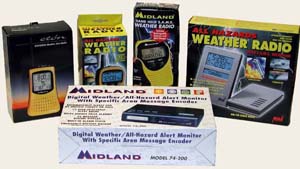| NOAA Magazine || NOAA Home Page |
NOAA JOINS CEA IN ANNOUNCING NEW
STANDARD FOR PUBLIC ALERT RECEIVERS
CEA-2009 Enables Consumers to Make Better Use of Public Alert Digital
Codes
 Jan.
9, 2004 — NOAA announced today
its collaborative effort with the Consumer Electronics Association to
develop a new performance standard for public alert receivers to protect
lives and property. The effort included the cooperation with Environment
Canada. Public Alert Receivers for NOAA
Weather Radio broadcasts using the new industry standards will be
entitled to bear a new certification from the Consumer
Electronics Association. The standard, titled CEA-2009 - Receiver
Performance Specification for Public Alert Receivers, defines minimum
performance criteria for consumer electronic products designed to receive
the digital alert signals broadcast by NWR and Environment Canada’s
Weatheradio network. (Click NOAA image for larger view of NOAA
Weather Radios from various manufacturers.)
Jan.
9, 2004 — NOAA announced today
its collaborative effort with the Consumer Electronics Association to
develop a new performance standard for public alert receivers to protect
lives and property. The effort included the cooperation with Environment
Canada. Public Alert Receivers for NOAA
Weather Radio broadcasts using the new industry standards will be
entitled to bear a new certification from the Consumer
Electronics Association. The standard, titled CEA-2009 - Receiver
Performance Specification for Public Alert Receivers, defines minimum
performance criteria for consumer electronic products designed to receive
the digital alert signals broadcast by NWR and Environment Canada’s
Weatheradio network. (Click NOAA image for larger view of NOAA
Weather Radios from various manufacturers.)
“The Public Alert designation is a new and vital initiative, and NOAA welcomes this chance to work with CEA and Environment Canada to bring this time critical information to consumers, emergency managers and others committed to keeping people and property out of harm's way,” said John J. Kelly, Jr., deputy undersecretary of commerce for oceans and atmosphere. “Broadcasting emergency messages over the all-hazard NOAA Weather Radio system can save lives and property, and I am very pleased that a range of CEA-2009 compliant products will soon be available to the American public.”
The standard enables consumers to make better use of warnings, watches and public alerts issued by NOAA. Messages broadcast by NOAA are the single source for comprehensive weather and emergency information available to the U.S. public. The standard expands the functionality of the receivers by increasing the options available to consumers about when and how they are notified of these alerts.
“It is important to have standards for products intended for public safety,” said Dwayne Campbell, chairman of the working group that developed the standard. “CEA-2009 establishes industry-wide standards for devices used to receive public safety alerts broadcast over the NOAA emergency alert system. This standard will help ensure products incorporating this technology provide reliable and consistent public warnings.”
The standard defines consistent alerting signals such as colored lights and LCD displays, that will indicate a public alert notice has been issued even when the device is in standby. This “push” technology greatly enhances the public safety aspect of Public Alert certified receivers by allowing users to make better use of the information available to them.
NOAA Weather Radio is a nationwide network of radio stations broadcasting continuous weather information from a nearby NOAA National Weather Service office. NWR transmits National Weather Service warnings, watches, forecasts and other hazard information 24 hours a day. In addition, NWR broadcasts warning and post-event information for all types of natural hazards, such as earthquakes and volcano activity, and technological events, such as chemical releases or oil spills.
The NWR network has more than 870 transmitters, covering the 50 states, adjacent coastal waters, Puerto Rico, the U.S. Virgin Islands and the U.S. Pacific Territories. The NOAA National Weather Service will discuss its capabilities at the 2004 International Consumer Electronics Show Jan. 7-11, 2004 in Las Vegas, Nevada in booth 23607 in the South Hall of the Las Vegas Convention Center.
The NOAA National Weather Service is the primary source of weather data, forecasts and warnings for the United States and its territories. The NOAA National Weather Service operates the most advanced weather and flood warning and forecast system in the world, helping to protect lives and property and enhance the national economy.
NOAA is dedicated to enhancing economic security and national safety through the prediction and research of weather and climate-related events and providing environmental stewardship of the nationís coastal and marine resources. NOAA is part of the U.S. Department of Commerce.
Relevant
Web Sites
NOAA Weather Radio
NOAA National Weather Service
NOAA Weather Radio: The Voice of the NOAA National Weather Service
Media
Contact:
Jordan
St. John, NOAA, (202) 482-5647